27.03.2024
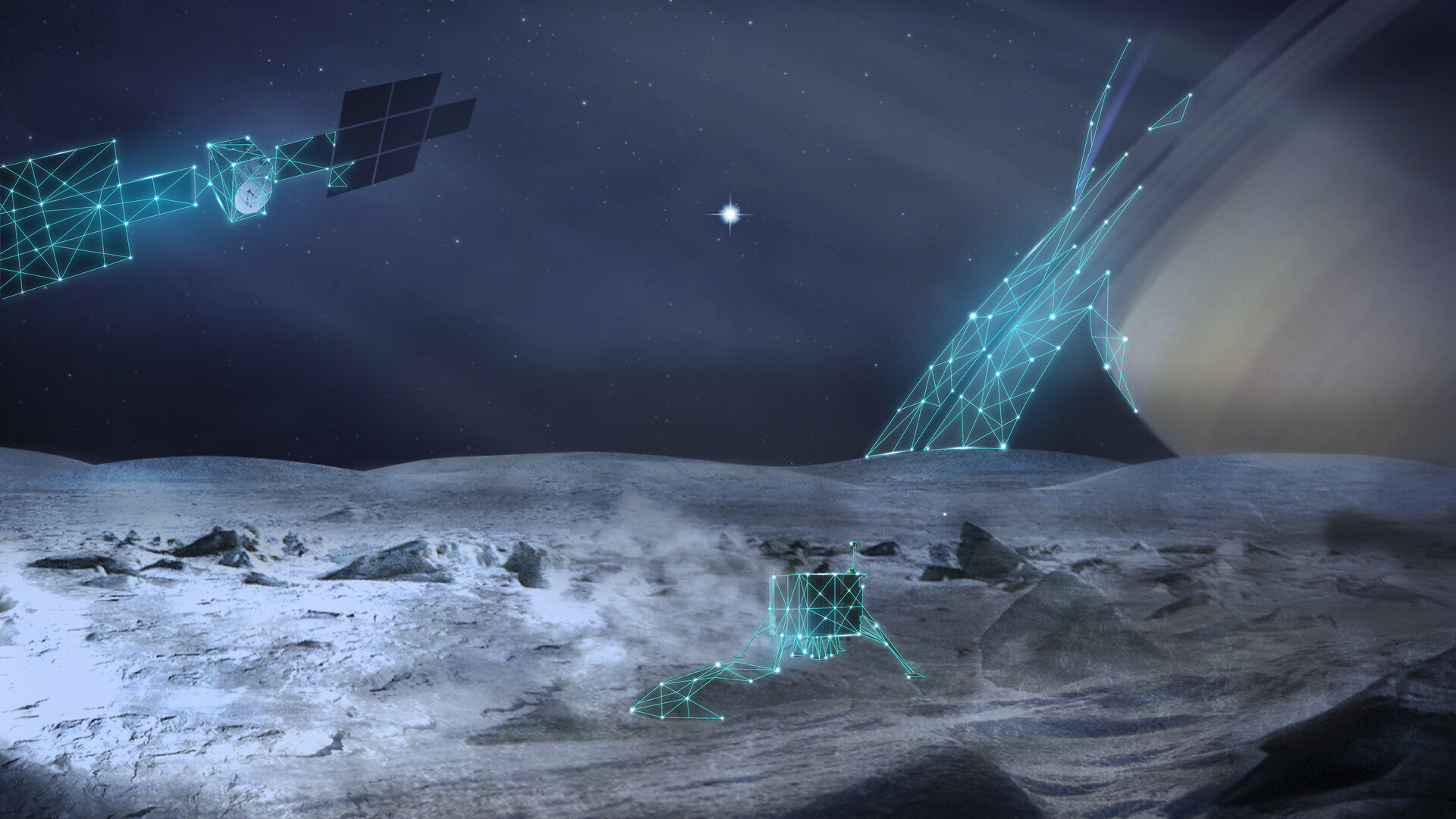
A fresh, icy crust hides a deep, enigmatic ocean. Plumes of water burst through cracks in the ice, shooting into space. An intrepid lander collects samples and analyses them for hints of life.
ESA has started to turn this scene into a reality, devising a mission to investigate an ocean world around either Jupiter or Saturn. But which moon should we choose? What should the mission do exactly? A team of expert scientists has delivered their findings.
The mission would follow Juice, LISA and NewAthena as the first ‘large-class’ mission of Voyage 2050, ESA’s long-term plan for space science activities. Its overarching theme – ‘moons of the giant Solar System planets’ – was chosen back in 2021. To translate this theme into more concrete mission concepts, ESA selected a committee of top planetary scientists to pool their knowledge and expertise.
Their task? To analyse the scientific merits of visiting various moons of Jupiter or Saturn, and help ESA map roads towards innovative technical solutions that would make such a mission possible.
Scientific priorities were set out as part of the Voyage 2050 recommendations: the mission should focus on the habitability of an ocean world by investigating the links between its interior and its surroundings, as well as searching for signs of past or present life, and seeking to identify life-enabling chemistry at the surface.
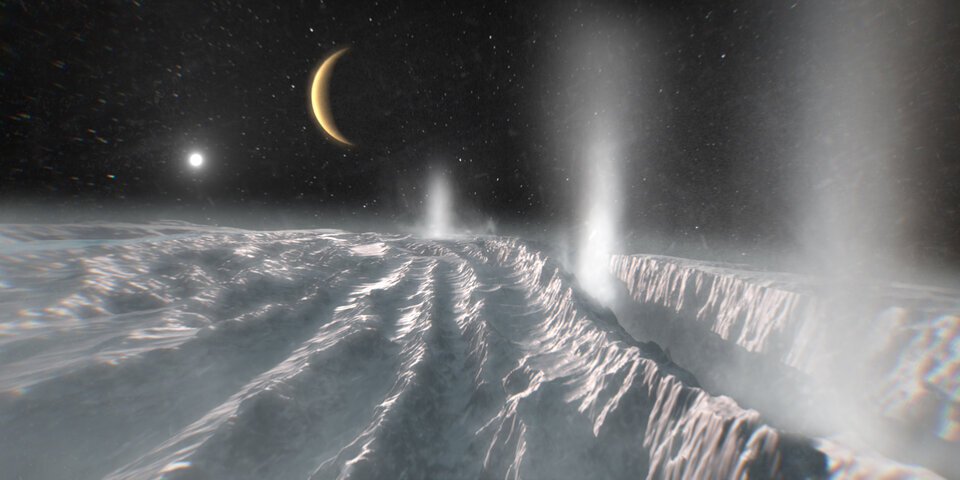
Moons of the giant planets
“The mission concepts that we have recommended would provide tremendous scientific return, driving forward our knowledge, and would be fundamental for the successful detection of biosignatures on icy moons,” says Dr Zita Martins, astrobiologist at Instituto Superior Técnico, who chaired the team of planetary scientists.
“I am very happy to have been part of this process, seeing first-hand the early steps that will potentially lead to the investigation of the moons of the giant planets by ESA. The search for habitable conditions and for signatures of life in the Solar System is challenging from a science and technology point of view, but very exciting!”
Ambitious but achievable. Always.
Of course, big dreams must always be kept within the bounds of what is technically feasible and financially affordable. As Dr Martin’s team focused on the science, teams of engineers within ESA’s Concurrent Design Facility (CDF) analysed what kind of mission would be realistic considering the technologies we expect to be developed within the next two decades.
“We commissioned three CDF studies focused on the most promising moons: Jupiter’s Europa and Saturn’s Enceladus and Titan,” elaborates Dr Frederic Safa, head of ESA’s Future Missions Department. “The team of scientists worked closely with the CDF engineers on the objectives of each study. The outcomes helped pin down what can be done with the resources that we will have in the 2040s.”
The results are in…
Aiming for transformational science, considering the characteristics of each moon and future planned missions to Jupiter and Saturn’s ocean worlds, the scientists identified Saturn’s moon Enceladus as the most compelling target, followed by Saturn’s moon Titan and then Jupiter’s moon Europa.
No space agency has ever landed on little Enceladus. And yet it has enormous potential for new science, particularly in the realm of habitability. It is generally accepted that there are three conditions for a ‘habitable environment’ to potentially support life as we know it: the presence of liquid water, a source of energy, and a specific set of chemical elements.

Enceladus checks all three boxes. The plumes that spew through its icy crust are rich in organic compounds, some of which are key for life. The ocean also seems to hold a powerful source of chemical energy that could fuel living organisms.
The impact of such a mission could be enormous It would offer Europe – once more – a unique front seat in Solar System science. “An investigation into signs of past or present life around Saturn has never been achieved before. It would guarantee ESA leadership in planetary science for decades to come,” says ESA Director of Science, Prof. Carole Mundell.
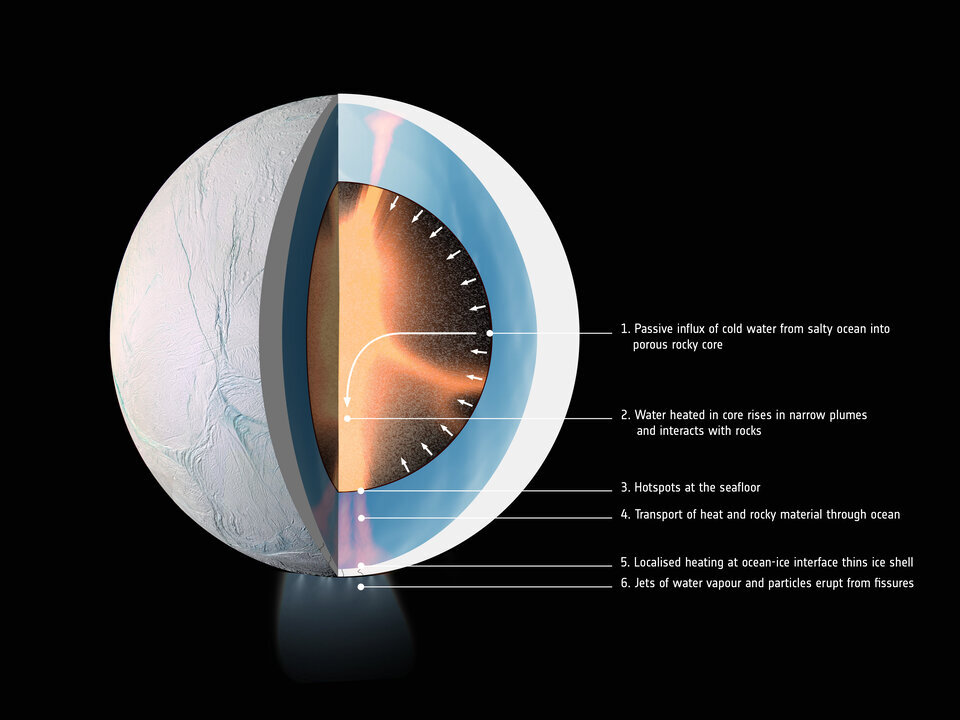
Standing on the shoulders of giants
Building upon ESA’s Jupiter Icy Moons Explorer (Juice) and the NASA/ESA/ASI Cassini-Huygens mission to visit Saturn and land on Titan, this new mission would carry next-generation instrumentation capable of revealing unimaginable secrets of an ocean world such as Enceladus. ESA could launch such a mission in the early 2040s with Ariane 6, arriving at its destination around a decade later. In the style of Juice and Cassini-Huygens, the mission – if targeted towards Enceladus or Titan – could perform a fantastic tour in the Saturn system, encompassing flybys of other puzzling moons, before a grand-finale close-up investigation of the chosen target.
To significantly advance European ambitions in planetary science, the team judged that the new mission must collect a sample of the ocean world, either using a lander or by flying close to the surface to sweep up material ejected by plumes. A mission to Enceladus would touch down at the moon’s thinly crusted south pole to collect ejected ocean material, whereas a mission to Titan should focus on lake sediments. In either case, an onboard laboratory equipped with miniaturised and highly sensitive instruments would unravel the biochemical secrets of the collected material.
Like Juice and Cassini-Huygens, our mission to the ‘moons of the giant Solar System planets’ will engage Europe’s foremost engineering and industrial capabilities to cope with enormous challenges, including limited solar energy, wildly varying temperatures and communication over huge distances. ESA is already overcoming similar challenges with Juice.
The new mission will boost European competences in many scientific and technological fields, including in-orbit assembly, operating in extreme environments, landing technologies, and novel scientific instrumentation. All these revolutionary technologies will have a wide range of applications, well beyond ESA’s space science programme.
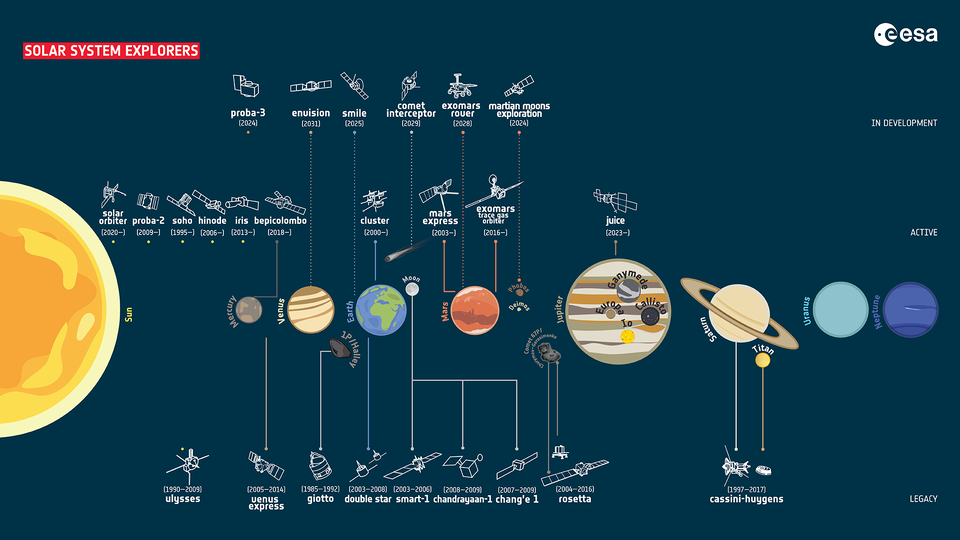
Space science at ESA
ESA has launched about one large-class mission per decade, with current and previous examples being Juice, Rosetta, XMM-Newton and Herschel. Each has been an enormously challenging endeavour, requiring the deployment of completely new technologies and engaging the efforts of thousands of leading scientists and engineers. A robust and stable space science programme ensures European excellence in science and technology; the significant societal impact generates the multi-disciplinary growth that ESA is called to provide to its Member States.
This new large-class mission to the ‘moons of the giant planets’ is the first in a series of three envisaged for ESA’s Voyage 2050 programme, to be complemented by a selection of medium- and fast-class missions. Together, these will provide diversity and agility over the next two decades, satisfying the ambition of European scientific communities. “In carefully planning Voyage 2050, we are ensuring that ESA’s space science programme secures a world-class, forward-looking set of missions for future generations,” concludes Prof. Mundell.
Quelle: ESA
----
Update: 17.06.2024
.
Is there life on one of Saturn’s moons? Scientists plan a mission to find out

The discovery of water on Enceladus excited the scientific world – now, by 2040 a robot probe will investigate if we are alone in the universe
t is a tiny world, a mere 310 miles in diameter, and was considered until recently to be one of the least interesting moons in the solar system. But Enceladus, one of 146 moons that orbit Saturn, has become a hot astronomical attraction – scientists have discovered that it offers one of the best prospects of finding life on another world in our solar system.
The European Space Agency (Esa) has announced it has begun planning a mission to take a robot probe across a billion miles of space to investigate.
It will be an extraordinarily taxing project. Apart from the colossal distance the probe will have to travel, it will need huge reserves of fuel to manoeuvre itself into orbit around Enceladus and then land on the ice-coated surface.
Nevertheless, the prospect of studying the little moon is enticing for astronomers who have discovered that Enceladus – first observed by William Herschel in 1789 – possesses geysers that regularly erupt from its surface and spray water into space. Even more astonishing, these plumes contain complex organic compounds, including propane and ethane.
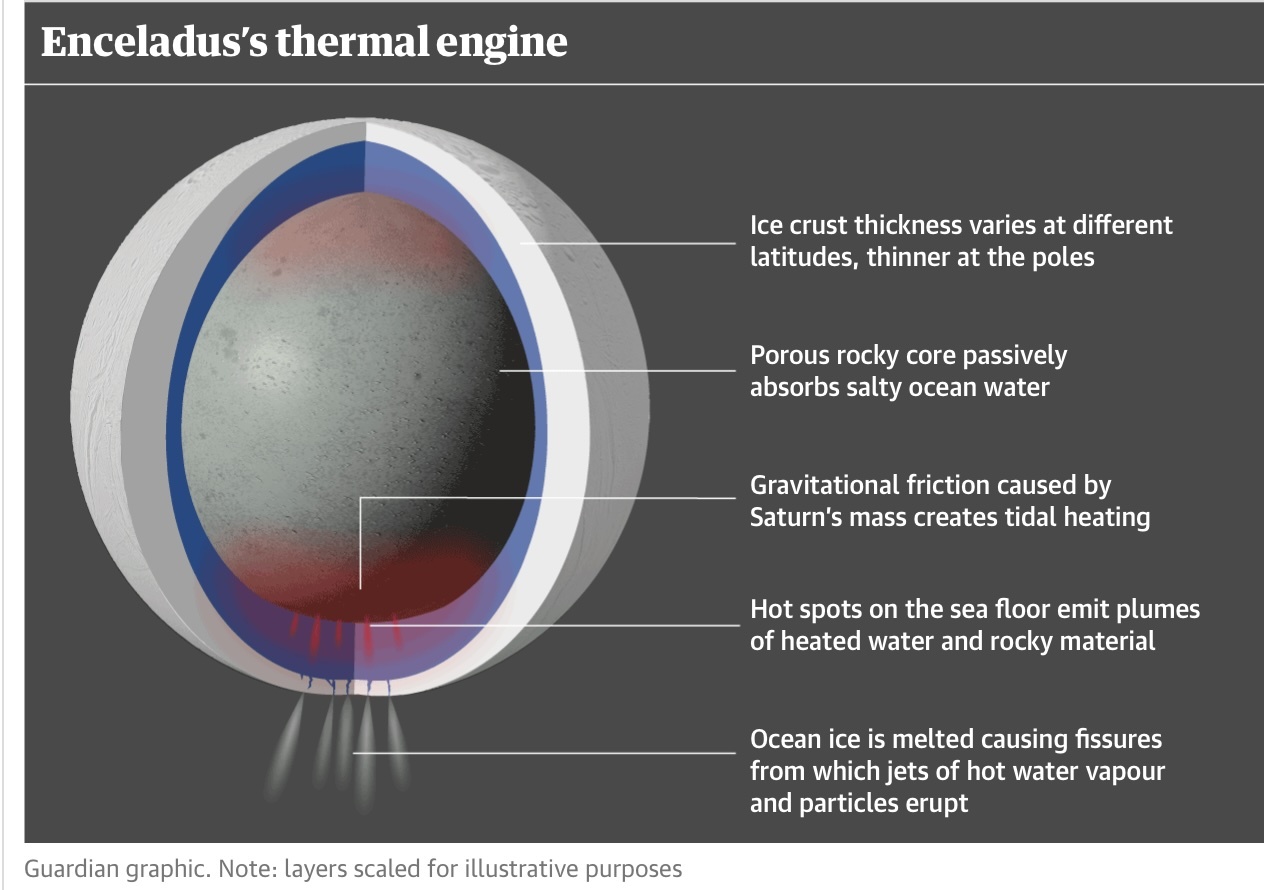
“Enceladus has three key ingredients that are considered to be essential for the appearance of life,” said astronomer Prof Michele Dougherty of Imperial College London. “It has got liquid water, organic material and a source of heat. That combination makes it my favourite moon in the whole solar system.”
This view is shared by Esa, which recently earmarked a mission to travel to a moon of Jupiter or Saturn as its next target for a major scientific endeavour. Such a project would be expected to deliver “a transformational scientific return”, according to a panel of expert scientists who studied three prime targets: Europa, the ice-covered moon of Jupiter; Titan, the hydrocarbon-rich moon of Saturn; and Enceladus. All possess subsurface oceans that hold the promise of sustaining alien lifeforms and would make first-class targets for scientific scrutiny.
After months of consideration, the panel reported a few weeks ago that it was the last on this interplanetary list, Enceladus, that should be given priority over the other targets. A mission should be launched by 2040 with the aim of either landing on the moon or flying through the geysers spraying water and carbon chemicals from its surface into space. Preferably, both goals would be attempted, the panel added.
“The mission would provide tremendous scientific return and would be fundamental for the successful detection of biosignatures on icy moons,” said Dr Zita Martins, an astrobiologist at Instituto Superior Técnico, who chaired the panel.
However, such goals will not be easy to achieve, as Dougherty pointed out last week. “It is one thing to put a probe into orbit round a large moon or planet that has a strong gravitational field that can slow down an incoming spacecraft. But Enceladus is small with weak gravity, which means you will need a lot of fuel to slow it down so that it does not whiz past its target into deep space. That is going to be a tricky issue for those designing the mission.”
Dougherty’s special interest in Enceladus stems from her role as principal investigator for the magnetometer flown on the Cassini mission that studied Saturn and its moons between 2004 and 2017.
“At one point, Cassini passed close to Enceladus and our instrument indicated Saturn’s magnetic field was being dragged round the moon in a way that suggested the little moon had an atmosphere,” said Dougherty.
Cassini’s managers agreed to direct the probe to take a closer look and, in July 2005, the spaceship swept over the moon’s surface at a height of 173km – and detected significant amounts of water vapour. “It was wonderful,” recalls Dougherty.
Subsequent sweeps produced even greater wonders. Huge geysers of water were pictured erupting from geological fault lines at the south pole. The only other body in the solar system, apart from Earth, possessing liquid water on its surface had been revealed. Finally came the discovery of organics in those plumes and Enceladus went from being rated a minor, unimportant moon to a world that is now set to trigger the expenditure of billions of euros and decades of effort by European astronomers and space engineers.
Life on other moons?
Titan
Another moon of Saturn and one of the largest in the solar system, Titan has lakes and seas of hydrocarbons; river channels; great stretches of dunes; and signs that it has a subsurface ocean that could provide a home for primitive life. It is also extraordinarily cold.
Mars
The red planet was a warm, watery world 4bn years ago and possessed ideal conditions for the appearance of life. However, Mars later lost its magnetic field, as well as its water and atmosphere, and was battered by intense ultraviolet radiation. Life would have found it difficult to survive on the surface but may have persisted, as microbes, underground.
Europa
One of the main moons of Jupiter, Europa is entirely covered with ice and has the smoothest surface of any known solid object in the Solar System. Beneath its surface, it has an ocean of water that scientists believe could harbour extraterrestrial life that would most likely consist of primitive bacteria-like entities.
Quelle: The Guardian
